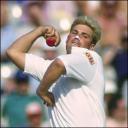How to have a club cricket indoor fielding session
Last night I ran a fielding only net session for my club.
As it's winter here the cold and dark restricted us to the local sports hall.
Normally we have a net session but I have long been gunning for more fielding practice and Sam, our club captain, decided he wanted the same and asked me to run a session. The session was an hour for around 14 adults ranging in skill from club first to third team. We had the whole hall to train in. All the equipment we had were 4 sets of spring loaded stumps, some bats and balls.
The perfect batting stance: Does it exist?
 Shiv Chanderpaul averages in the high 40's in Test cricket yet if I saw a kid I was coaching with a front on stance like that I would be jumping to correct such a glaring error.
Shiv Chanderpaul averages in the high 40's in Test cricket yet if I saw a kid I was coaching with a front on stance like that I would be jumping to correct such a glaring error.
What gives?
The short answer is that everyone is different. That doesn't explain it enough for me though. Surely simple physics dictates a biomechanically perfect setup and backswing that everyone should be doing. So why is there variation?
Has Twenty20 changed club cricket?
I'm pretty sure Jeremy Snape wasn't referring to club cricket when he said this:
Warning: Is your cricket club losing kids?
Recently I saw a coaching session that seemed to be designed not for the kids to have fun but for the coaches to impress their own will to win.
I can just imagine the drop out rate.
The reason kids come to play cricket, in my view, is to have fun. Winning is a factor but without the enjoyment more will leave than stay.
How do good coaches go about this while still teaching the skills of the game?
Keep everyone involved
You can’t improve what you don’t measure
Cricket is a statisticians dream. Every aspect of a cricketer's performance is measured by statistics. The great players are often separated from the good players based on statistics.
For those that did not get a chance to witness the great Don Bradman bat, the only way they know he was perhaps the best batsman that ever lived was in is amazing batting average of 99.94.
7 things club coaches don't teach (but should do)
Long time reader Arvind got in touch about this post:
If sledging were to be accepted as a part of the game of cricket, would we then have to coach it like the other disciplines?
That got me to thinking. Is he right and if so what else should coaches be coaching at club level?
How to find a good cricket coach
Back when I was doing my ECB coaching award we were practicing leg spin under the watchful eye of our coach tutors. I'll be the first to admit I make no claims as a bowler, let a lone leg spin. Suffice to say, I was pretty poor, even with a tennis ball in a sports hall.
The tutor spotted my efforts in the group and wandered over. "You are planting your front leg too far across David," he said. "Try landing your front foot more towards the off side."
Free cricket coaching: Volunteers needed for case studies
*Update: Applications are now closed.*
Do you want some free coaching and advice? This year I want to get more in depth and detailed with the advice I give you. I figure the best way to do this is to pick some readers as examples of what can be achieved.
After all, harrowdrive is in its 3rd year and it's time togive you some real life examples. I'm putting my money where my mouth is.
What do great spinners have in common?
 Warne, Bedi, Kumble, Muralitharan: The techniques of spin are as varied as the men who mastered it. However great spinners also have many things in common. If you can understand and copy these methods you can improve your own skill as a spinner.
Warne, Bedi, Kumble, Muralitharan: The techniques of spin are as varied as the men who mastered it. However great spinners also have many things in common. If you can understand and copy these methods you can improve your own skill as a spinner.
- Action. Spinners actions vary greatly but all great spinners have an action they can rely on. For most this will be side on to generate more spin. England off spinner Ray Illingworth likens his action to a cartwheel turning forward in a straight line. Practice with and without a batsman until it is automatic.

